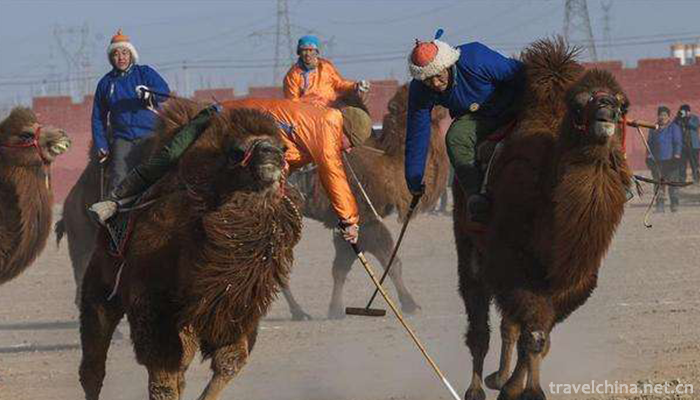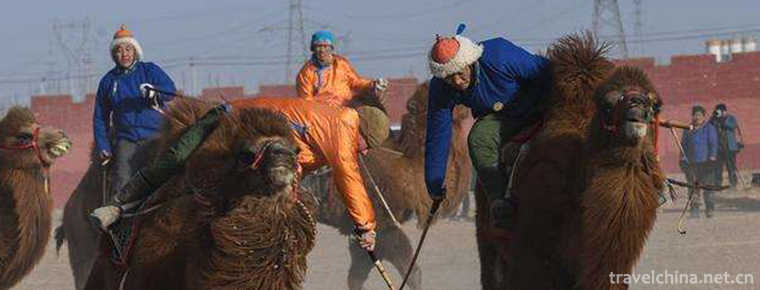Mongolian camel ball
Mongolian camel ball
The intangible cultural heritage is the manifestation and cultural space of various traditional cultures which are inherited from generation to generation and closely related to people's life. The intangible cultural heritage is not only the witness of historical development, but also the precious and valuable cultural resources. In 2014, the State Council approved the fourth batch of 153 representative projects of national intangible cultural heritage determined by the Ministry of Culture, and the Mongolian camel ball project of Urat Houqi was included in the fourth batch of representative projects of national intangible cultural heritage.
It is reported that Mongolian camel ball evolved from Polo competition. At first, it was only a non-governmental organization's competitive game, without strict competition rules. As long as the venue was slightly smoother, it could be carried out easily. Therefore, it quickly became popular on the grassland. After continuous development and improvement, it formed unique competition rules. Since then, an international camel ball game has been held every year, which is very popular among farmers and herdsmen.
In some areas of Inner Mongolia, camel games are held every festival (including Nadam Convention and Spring Festival). The growing prosperity of camel Games has also led to the development of herdsmen's folk sports. Up to now, Urat Houqi has formed 30 camel teams and more than 300 successors. They have participated in nearly 100 camel Invitational competitions, performance competitions and competitive competitions organized by various regions, and have been invited to participate in the Mongolian International Camel Championship League. The Mongolian camel ball reflects the historical evolution process of the Urat Mongolian people, and reflects the healthy concept and national spirit of the grassland children, who are strong in body, strive hard, natural and frank, and live in harmony with nature. It has distinct regionalism and strong national character.


-
1.steamed vermicelli roll
Intestinal powder originated in Luoding, Guangdong Province, has been spread throughout the country. According to geography (taste), it can be distinguished from the well-known
Time 2018-11-02 -
2.Three Gorges Household Scenic Area
Three Gorges Household Scenic Area, National AAAAA Class Tourist Area, the First Batch of Civilized Scenic Area in Hubei Province, Top Ten Scenic Spots in Hubei Province
Time 2018-12-12 -
3.Kaiping Diaolou and Villages
In Kaiping city, there are many blockhouses, towns and countryside. There are more than a dozen villages and less than two or three villages. From Shuikou to Lily
Time 2019-01-29 -
4.Eight dishes
Eight-flavor dish is a delicacy, the main ingredients are green pepper, 1000 grams; soybean, 1000 grams; head vegetables, 3000 grams; sugar, 250 grams; vinegar, 250 grams; salt, 250 grams; soy sauce,
Time 2019-03-27 -
5.Bai opera
After 1949, on the basis of blowing tunes, Bai folk opera "Dabenqu" tunes were further enriched and improved, renamed "Baiju". The Lyric forms are basically sung in Bai language an
Time 2019-04-03 -
6.Legend of Kirin
The legend of Kirin is mainly spread in Jiaxiang County of Shandong Province and its surrounding areas. Kirin is an auspicious God and animal in ancient legends. Ancient books say
Time 2019-06-10 -
7.Qingyang Xiangbao embroidery
According to the pattern of paper-cut, various patterns are embroidered on the silk fabric with colorful thread, then different shapes are sewn, and the inner core is filled with silk, cotton and spic
Time 2019-06-11 -
8.Linear cavity
Line-tune opera, also known as Line-score opera, is an ancient traditional opera in Shanxi Province. It first appeared in the Han and Tang Dynasties, and developed greatly. It flourished in the Song D
Time 2019-07-03 -
9.Maogus Dance of Tujia Nationality in Western Hunan
Maogus Dance of Tujia Nationality in Western Hunan Province, the traditional dance of Tujia and Miao Autonomous Prefecture in Western Hunan Province, is one of the national intangible cultural heritag
Time 2019-07-06 -
10.Legend of Yongding River
Yongding River legend is one of the local folklores in Beijing. Among many legends, the legend of river blocking is representative; the legend of Shijing Mountain and Shijing Mountain; the legend of b
Time 2019-07-14 -
11.Yongxin Shield Dance
Shield dance, also known as men's group dance rattan dance, roll the shield, reflects the most primitive national cohesion, team spirit and fighting spirit. Shield dance is mainly spread in Longyuanko
Time 2019-07-14 -
12.Zhuxian Town Wood Print New Year Picture
Zhuxianzhen Wood Engraving New Year Picture is one of the ancient Chinese traditional crafts. As the originator of Chinese woodcut New Year pictures, is mainly distributed in Kaifeng, Zhuxian Town and
Time 2019-08-10